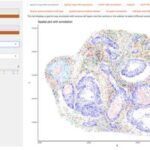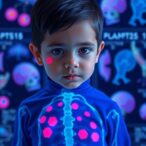
In recent years, the medical community has grown increasingly aware of racial and ethnic disparities in healthcare outcomes, highlighting the critical importance of equitable diagnostic tools. One such instrument under scrutiny is the pulse oximeter, widely used in clinical settings to non-invasively measure blood oxygen saturation levels. Despite its ubiquitous role in patient monitoring, mounting evidence reveals that pulse oximeters commonly produce less accurate readings for individuals with darker skin tones. This discrepancy arises primarily from the device’s reliance on differential light absorption by hemoglobin through the skin—a process complicated by variations in skin pigmentation. Addressing this significant shortfall, a team of researchers from Brown University and Morgan State University has pioneered an innovative solution that leverages the ubiquity and imaging capabilities of smartphones to objectively quantify skin tone, aiming to enhance the accuracy and equity of pulse oximetry.
The core technological challenge lies in the fact that the pulse oximeter’s photoelectric sensors detect oxygen saturation through wavelengths of light transmitted or reflected from blood vessels lying beneath the skin. Melanin, the pigment responsible for skin color, variably absorbs and scatters light, resulting in altered sensor responses in individuals with higher melanin concentrations. This optical interference often leads to a systematic overestimation of oxygen saturation for people with darker skin tones, which in turn risks misdiagnosis and delays in critical medical interventions. Clinicians, lacking direct measurements of skin pigmentation, have traditionally resorted to self-reported race or ethnicity as rough proxies during diagnosis—methods fraught with inaccuracy and ambiguity due to the heterogeneity within racial categories. Recognizing the urgent need for a direct, quantitative assessment of skin tone, the research consortium turned to advanced colorimetric analysis performed via commonly available smartphone cameras.
The approach involves capturing high-fidelity images of skin at anatomical sites routinely used for pulse oximetry, such as the fingertip, with smartphone cameras set to controlled parameters to ensure consistency and reproducibility. Researchers applied tristimulus colorimetry, a method that quantifies color by decomposing light into three primary components corresponding roughly to human cone cell responses. From the captured RGB data, they calculated the individual typology angle (ITA), a standardized color metric that offers a reproducible scalar value representing skin tone across a continuous spectrum. ITA effectively encapsulates the chromaticity and luminance of the skin region of interest, allowing for more precise and objective categorization compared to subjective visual assessments or self-identification. This calculated value was then rigorously validated against readings from a professional-grade, laboratory-standard colorimeter known for high accuracy in skin tone measurement.
.adsslot_4kNHL8VpGc{ width:728px !important; height:90px !important; }
@media (max-width:1199px) { .adsslot_4kNHL8VpGc{ width:468px !important; height:60px !important; } }
@media (max-width:767px) { .adsslot_4kNHL8VpGc{ width:320px !important; height:50px !important; } }
ADVERTISEMENT
Experimental results from the study demonstrated that, under carefully controlled lighting conditions, the smartphone-based measurements of ITA closely adhered to those obtained from the expensive colorimeter devices. Specifically, optimal conditions involved disabling the smartphone camera’s automatic exposure adjustments and flash, and performing measurements in darkened environments to minimize ambient light variability. By setting manual exposure levels, the researchers achieved a high degree of repeatability and precision in skin tone measurements irrespective of individual skin pigmentation. This discovery is compelling because it reveals that no specialized hardware beyond a standard smartphone is necessary, pointing towards an accessible, low-cost method for real-time skin tone assessment in diverse healthcare environments.
The implications of this methodology extend beyond mere cosmetic diagnostics. By integrating accurate skin tone measurements into pulse oximetry calibration protocols, healthcare providers can correct for pigmentation-related biases, thereby reducing the risk of hypoxemia under-detection in patients with darker skin. This advancement offers a pathway toward mitigating racial disparities in oxygen saturation monitoring—an issue brought sharply into focus by the COVID-19 pandemic, wherein accurate respiratory assessment was critical. Moreover, because the entire imaging and analysis process fits within the software capabilities of a smartphone, this technology possesses the scalability and portability essential for broad adoption, including in resource-limited settings where expensive spectroscopic devices are unavailable.
While the technology’s promise is clear, the study’s scope was preliminary, involving a limited cohort of young adult participants and controlled, non-clinical environments. The authors candidly acknowledge that further research is necessary to validate the approach across larger, more diverse populations and under the dynamic lighting and environmental conditions typical of clinical settings. The intersection of illumination variability, skin texture, and anatomical location requires detailed exploration to ensure consistent performance in real-world applications. Nonetheless, the foundational findings provide a novel framework for bridging the gap between engineering innovation and clinical need, emphasizing the importance of inclusive biomedical device design that accounts for demographic diversity.
The researchers have also outlined pragmatic guidelines for clinical personnel intending to implement this technique. These include avoiding measurements over skin anomalies such as tattoos, scars, or lesions that could confound colorimetry readings, maintaining a consistent distance and angle between the camera lens and the skin surface, and disabling automatic camera functionalities that might alter color data. Adoption of standardized protocols will be vital to maintain data integrity and ensure meaningful comparisons across different devices and patient populations.
This study harnesses the intersection of photonics, biomedical engineering, and mobile technology, underscoring the transformative potential of consumer devices in medical diagnostics. By shifting from reliance on imprecise racial proxies to direct, algorithm-driven skin tone metrics, the research holds promise to enrich personalized medicine strategies and optimize device calibration. As pulse oximeters remain integral to a broad array of medical scenarios—from surgical suites to home care—embedding such colorimetric analysis could substantially improve diagnostic accuracy and health equity on a global scale.
In an era when artificial intelligence and machine learning continue to augment healthcare capabilities, coupling smartphone-based colorimetry with advanced data analytics may powerfully refine pulse oximetry algorithms. Such integration could account dynamically for individual pigmentation and other physiological variables, paving the way for real-time, adaptive monitoring. The simplicity and affordability of using smartphones also align well with global health initiatives seeking to democratize access to quality medical tools, particularly in underserved regions.
This innovative convergence of technology and medicine exemplifies how interdisciplinary collaboration can address long-standing disparities in healthcare tools. With further validation and clinical integration, smartphone-based skin tone measurement may join other cutting-edge diagnostic methodologies in reshaping healthcare delivery. Ultimately, this work offers a compelling example of how everyday technology can be repurposed to serve as a powerful ally in the pursuit of health equity, precision, and improved patient outcomes.
For detailed methodology, data analysis, and further discussion, the study appears in the peer-reviewed open-access journal Biophotonics Discovery, highlighting the importance of color science in biological and medical applications. As this research progresses toward clinical translation, it opens new avenues for developers, clinicians, and policymakers committed to fostering more inclusive and accurate diagnostic instrumentation across populations of all skin tones.
Subject of Research: Smartphone-based skin tone measurement to improve pulse oximetry accuracy.
Article Title: Smartphone tristimulus colorimetry for skin-tone analysis at common pulse oximetry anatomical sites
News Publication Date: 19-May-2025
Web References:
https://www.spiedigitallibrary.org/journals/biophotonics-discovery/volume-2/issue-03/032504/Smartphone-tristimulus-colorimetry-for-skin-tone-analysis-at-common-pulse/10.1117/1.BIOS.2.3.032504.full
References:
Burrow, J. A., et al. “Smartphone tristimulus colorimetry for skin-tone analysis at common pulse oximetry anatomical sites,” Biophotonics Discovery 2(3), 032504 (2025). DOI: 10.1117/1.BIOS.2.3.032504
Image Credits: J. A. Burrow (Morgan State and Brown University).
Keywords
Optics, Smartphones, Biometrics, Human biology
Tags: addressing healthcare inequalitiesadvancements in medical imaging solutionsequitable diagnostic tools in medicineimpact of skin pigmentation on health monitoringimproving medical device performance for diverse populationsmelanin effects on light absorptionnon-invasive blood oxygen measurement techniquespulse oximeter accuracy issuesracial disparities in medical devicesresearch on skin tone and medical accuracyskin tone measurement innovationssmartphone technology in healthcare



